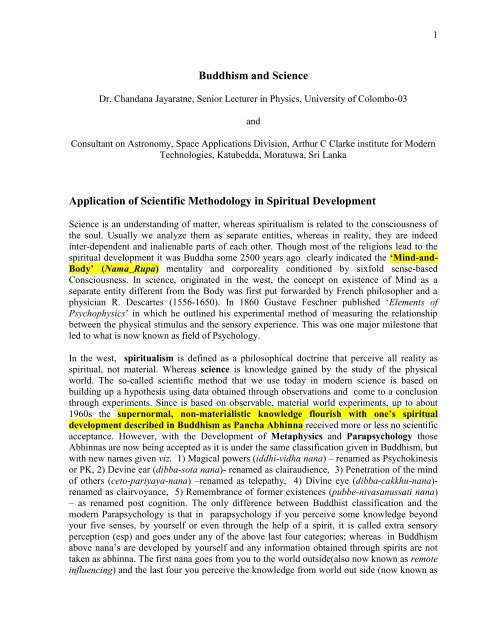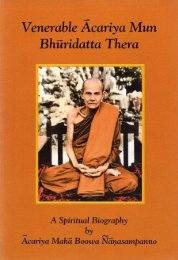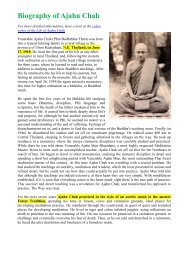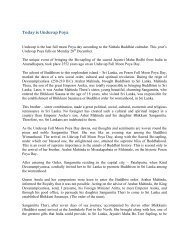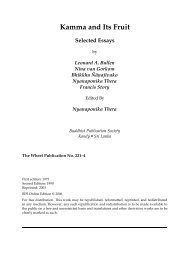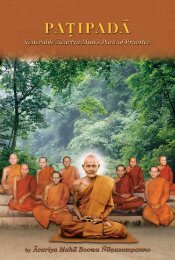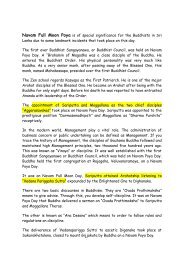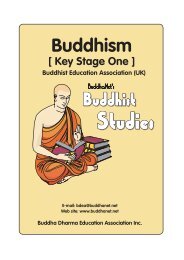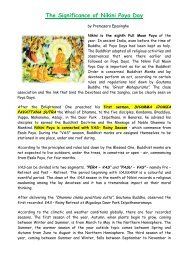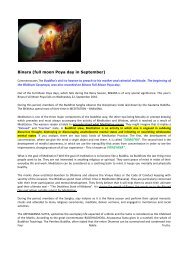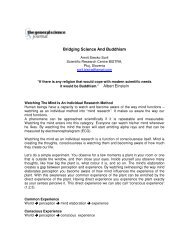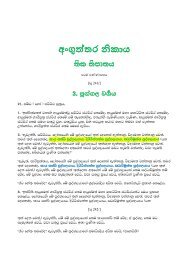In today's world, spiritualism has become a way of life in fashion ...
In today's world, spiritualism has become a way of life in fashion ...
In today's world, spiritualism has become a way of life in fashion ...
You also want an ePaper? Increase the reach of your titles
YUMPU automatically turns print PDFs into web optimized ePapers that Google loves.
1<br />
Buddhism and Science<br />
Dr. Chandana Jayaratne, Senior Lecturer <strong>in</strong> Physics, University <strong>of</strong> Colombo-03<br />
and<br />
Consultant on Astronomy, Space Applications Division, Arthur C Clarke <strong>in</strong>stitute for Modern<br />
Technologies, Katubedda, Moratuwa, Sri Lanka<br />
Application <strong>of</strong> Scientific Methodology <strong>in</strong> Spiritual Development<br />
Science is an understand<strong>in</strong>g <strong>of</strong> matter, whereas <strong>spiritualism</strong> is related to the consciousness <strong>of</strong><br />
the soul. Usually we analyze them as separate entities, whereas <strong>in</strong> reality, they are <strong>in</strong>deed<br />
<strong>in</strong>ter-dependent and <strong>in</strong>alienable parts <strong>of</strong> each other. Though most <strong>of</strong> the religions lead to the<br />
spiritual development it was Buddha some 2500 years ago clearly <strong>in</strong>dicated the ‘M<strong>in</strong>d-and-<br />
Body’ (Nama_Rupa) mentality and corporeality conditioned by sixfold sense-based<br />
Consciousness. <strong>In</strong> science, orig<strong>in</strong>ated <strong>in</strong> the west, the concept on existence <strong>of</strong> M<strong>in</strong>d as a<br />
separate entity different from the Body was first put forwarded by French philosopher and a<br />
physician R. Descartes (1556-1650). <strong>In</strong> 1860 Gustave Feschner published „Elements <strong>of</strong><br />
Psychophysics‟ <strong>in</strong> which he outl<strong>in</strong>ed his experimental method <strong>of</strong> measur<strong>in</strong>g the relationship<br />
between the physical stimulus and the sensory experience. This was one major milestone that<br />
led to what is now known as field <strong>of</strong> Psychology.<br />
<strong>In</strong> the west, <strong>spiritualism</strong> is def<strong>in</strong>ed as a philosophical doctr<strong>in</strong>e that perceive all reality as<br />
spiritual, not material. Whereas science is knowledge ga<strong>in</strong>ed by the study <strong>of</strong> the physical<br />
<strong>world</strong>. The so-called scientific method that we use today <strong>in</strong> modern science is based on<br />
build<strong>in</strong>g up a hypothesis us<strong>in</strong>g data obta<strong>in</strong>ed through observations and come to a conclusion<br />
through experiments. S<strong>in</strong>ce is based on observable, material <strong>world</strong> experiments, up to about<br />
1960s the supernormal, non-materialistic knowledge flourish with one’s spiritual<br />
development described <strong>in</strong> Buddhism as Pancha Abh<strong>in</strong>na received more or less no scientific<br />
acceptance. However, with the Development <strong>of</strong> Metaphysics and Parapsychology those<br />
Abh<strong>in</strong>nas are now be<strong>in</strong>g accepted as it is under the same classification given <strong>in</strong> Buddhism, but<br />
with new names given viz. 1) Magical powers (iddhi-vidha nana) – renamed as Psychok<strong>in</strong>esis<br />
or PK, 2) Dev<strong>in</strong>e ear (dibba-sota nana)- renamed as clairaudience, 3) Penetration <strong>of</strong> the m<strong>in</strong>d<br />
<strong>of</strong> others (ceto-pariyaya-nana) –renamed as telepathy, 4) Div<strong>in</strong>e eye (dibba-cakkhu-nana)-<br />
renamed as clairvoyance, 5) Remembrance <strong>of</strong> former existences (pubbe-nivasanussati nana)<br />
– as renamed post cognition. The only difference between Buddhist classification and the<br />
modern Parapsychology is that <strong>in</strong> parapsychology if you perceive some knowledge beyond<br />
your five senses, by yourself or even through the help <strong>of</strong> a spirit, it is called extra sensory<br />
perception (esp) and goes under any <strong>of</strong> the above last four categories; whereas <strong>in</strong> Buddhism<br />
above nana‟s are developed by yourself and any <strong>in</strong>formation obta<strong>in</strong>ed through spirits are not<br />
taken as abh<strong>in</strong>na. The first nana goes from you to the <strong>world</strong> outside(also now known as remote<br />
<strong>in</strong>fluenc<strong>in</strong>g) and the last four you perceive the knowledge from <strong>world</strong> out side (now known as
2<br />
remote view<strong>in</strong>g or esp) through extra sensory perception. <strong>In</strong> <strong>today's</strong> <strong>world</strong>, <strong>spiritualism</strong> <strong>has</strong><br />
<strong>become</strong> a <strong>way</strong> <strong>of</strong> <strong>life</strong> like food and dr<strong>in</strong>k, exercise, and is a path taken by millions <strong>world</strong>wide.<br />
Use <strong>of</strong> modern scientific knowledge and <strong>in</strong>struments to understand those Pancha Abh<strong>in</strong>nas<br />
and some <strong>of</strong> the concepts described <strong>in</strong> Buddhism gave an tremendous impact to the acceptance<br />
<strong>of</strong> Buddhism as a <strong>world</strong> religion with practical applicability than any other religion.<br />
Development <strong>of</strong> several scientific methods and <strong>in</strong>struments such as ESP test kits, computer<br />
generated methods on test<strong>in</strong>g esp ability <strong>of</strong> <strong>in</strong>dividual persons, electroencephalographs (EEG)<br />
to record bra<strong>in</strong> wave patterns, artificial stimuli given to certa<strong>in</strong> sections <strong>of</strong> the bra<strong>in</strong> that will<br />
regenerate some <strong>of</strong> above conditions and the Frequency Follow<strong>in</strong>g Response (FFR) technique<br />
developed after study<strong>in</strong>g the bra<strong>in</strong> wave patterns under meditation to regenerate similar state<br />
<strong>of</strong> trance had lead to study the Buddhist meditation techniques and concepts like Pancha<br />
Abh<strong>in</strong>nna by the scientists <strong>in</strong> the west giv<strong>in</strong>g much recognition to the Buddhism and its<br />
application <strong>in</strong> daily <strong>life</strong>.<br />
So much so that these fields are now recognized with open<strong>in</strong>g up <strong>of</strong> departments with<br />
pr<strong>of</strong>essors and doctoral students <strong>in</strong> universities like Ed<strong>in</strong>burgh <strong>in</strong> UK. These research are<br />
more focused on the areas <strong>of</strong> mechanisms <strong>of</strong> psi, electromagnetic sensitivity and psi,<br />
observer‟s impact on an event, psychok<strong>in</strong>esis research, direct mental <strong>in</strong>teractions with liv<strong>in</strong>g<br />
systems (DMILS), precognition and <strong>in</strong>tervention, the nature <strong>of</strong> operation <strong>of</strong> volition,<br />
psychological correlates <strong>of</strong> ESP, altered status <strong>of</strong> consciousness, the phenomenology <strong>of</strong><br />
psychology <strong>of</strong> the OBE(Out-<strong>of</strong>-Body-Experience). It is well-known that technologically<br />
advanced nations are now hav<strong>in</strong>g separate military units established on Remote Vision,<br />
Remote <strong>In</strong>fluence – as a latest technique <strong>of</strong> spy<strong>in</strong>g. Like many other branches <strong>of</strong> the science<br />
(e.g atomic energy) with the <strong>in</strong>troduction <strong>of</strong> Extra Sensory Perception <strong>in</strong> to military<br />
applications the field <strong>of</strong> <strong>spiritualism</strong> today <strong>has</strong> began to grow fast scientifically. The recent<br />
discovery(dur<strong>in</strong>g the Iraq war) <strong>of</strong> how telepathy work to exchange global <strong>in</strong>formation between<br />
human m<strong>in</strong>ds through Schuman Resonance described <strong>in</strong> electromagnetic theory (7.52 Hz<br />
frequency <strong>of</strong> a em wave travel<strong>in</strong>g round the <strong>world</strong>) and alpha level <strong>of</strong> m<strong>in</strong>d reached under<br />
meditation (frequency 7-14 Hz) is one such example.<br />
Development <strong>of</strong> Scientific background on Bra<strong>in</strong>waves and meditation<br />
Discovery <strong>of</strong> EEG (Electroencephalogram)<br />
Although scientists knew flicker<strong>in</strong>g light and audio beats affected our frame <strong>of</strong> m<strong>in</strong>d, they<br />
were unable to prove how that <strong>in</strong>teraction existed. Then <strong>in</strong> 1924, Hans Burger, a German<br />
psychiatrist, published pictures depict<strong>in</strong>g electrical activity <strong>of</strong> the human bra<strong>in</strong>. From the<br />
discovery <strong>of</strong> these "wavy" l<strong>in</strong>es emerged a new scientific field called<br />
"electroencephalography". Bra<strong>in</strong> cells communicate by produc<strong>in</strong>g t<strong>in</strong>y electrical impulses.<br />
Dur<strong>in</strong>g EEG studies, researchers place several electrodes on a subject's scalp to detect and<br />
record patterns <strong>of</strong> electrical activity <strong>in</strong> the bra<strong>in</strong>.<br />
Dur<strong>in</strong>g the 1940's several researchers, <strong>in</strong>clud<strong>in</strong>g W. Gray Walter, utilized powerful electronic<br />
strobes with new versions <strong>of</strong> EEG <strong>in</strong>strumentation to alter bra<strong>in</strong>wave activity, produc<strong>in</strong>g states
3<br />
<strong>of</strong> pr<strong>of</strong>ound relaxation and imagery. <strong>In</strong> 1949, bra<strong>in</strong>wave signals were brought to the screen<br />
with the <strong>in</strong>vention <strong>of</strong> the Tuposcope. This breakthrough allowed the track<strong>in</strong>g <strong>of</strong> bra<strong>in</strong>wave<br />
patterns (Beta, Alpha, Theta and Delta). With<strong>in</strong> five years, hundreds <strong>of</strong> hospitals were<br />
equipped with EEG‟s.<br />
<strong>In</strong> the 1950's and 1960's, research on Zen and Yoga meditators showed a predom<strong>in</strong>ance<br />
<strong>of</strong> alpha and theta waves dur<strong>in</strong>g meditation. These f<strong>in</strong>d<strong>in</strong>gs were made through the data<br />
collected by researchers <strong>in</strong>clud<strong>in</strong>g M.A. Wanger <strong>of</strong> the University <strong>of</strong> California at Los<br />
Angeles; B.K. Bagchi <strong>of</strong> the University <strong>of</strong> Michigan School <strong>of</strong> Medic<strong>in</strong>e; and B.K. Anand <strong>of</strong><br />
the All <strong>In</strong>dia <strong>In</strong>stitute <strong>of</strong> Medical Sciences <strong>in</strong> New Delhi (Ditson-Sommer 1995).<br />
Dur<strong>in</strong>g the late 1960's and <strong>in</strong>to the 1970's <strong>in</strong>terest <strong>in</strong> produc<strong>in</strong>g altered states without<br />
chemicals <strong>in</strong>creased. Alpha EEG feedback by Dr. Joe Kamiya at Langley-Porter<br />
Neuropsychiatry <strong>In</strong>stitute <strong>in</strong> San Francisco aided <strong>in</strong> <strong>in</strong>itiat<strong>in</strong>g the age <strong>of</strong> bi<strong>of</strong>eedback. Others,<br />
<strong>in</strong>clud<strong>in</strong>g Jack Schwarz and Richard Townsend, cont<strong>in</strong>ued their <strong>in</strong>vestigations <strong>of</strong> rhythmic<br />
light and sound comb<strong>in</strong>ations, with emp<strong>has</strong>is on hemispheric bra<strong>in</strong> synchronization and EEG<br />
entra<strong>in</strong>ment (Budzynski, 1991).<br />
How Are Frequencies Associated With Bra<strong>in</strong>waves?<br />
Bra<strong>in</strong>waves are the electrical wave patterns generated <strong>in</strong> every person‟s bra<strong>in</strong>. These waves<br />
vary accord<strong>in</strong>g to level <strong>of</strong> consciousness, subconsciousness and unconsciousness and are<br />
characterized by four dist<strong>in</strong>ct types <strong>of</strong> bra<strong>in</strong>waves. Each <strong>of</strong> these electrical wave patterns have<br />
dist<strong>in</strong>ctly different <strong>way</strong>s <strong>of</strong> perceiv<strong>in</strong>g, process<strong>in</strong>g, learn<strong>in</strong>g and know<strong>in</strong>g <strong>in</strong>formation<br />
(Hoiberg, 1989). All <strong>of</strong> these bra<strong>in</strong> waves are produced at all times. However, a predom<strong>in</strong>ance<br />
<strong>of</strong> a specific desired bra<strong>in</strong>wave state can be created at will, which allows a person to<br />
potentialize his or her capabilities towards achiev<strong>in</strong>g human excellence.<br />
Bra<strong>in</strong>wave frequencies are described <strong>in</strong> terms <strong>of</strong> hertz (Hz), or cycles per second, which are<br />
measured by the electroencephalogram (EEG) described above. Gamma bra<strong>in</strong>wave<br />
frequencies are a high frequency pattern beg<strong>in</strong>n<strong>in</strong>g at thirty-five hertz. There <strong>has</strong> been some<br />
evidence that gamma frequencies are associated with states <strong>of</strong> peak performance. Most light<br />
and sound <strong>in</strong>struments have the capability to generate gamma frequencies. While <strong>in</strong> this<br />
bra<strong>in</strong>wave state, sensations are centered on be<strong>in</strong>g mentally, emotionally and physically<br />
"charged" or extremely energized. These frequencies are the highest known bra<strong>in</strong>wave<br />
patterns, but are considered to be part <strong>of</strong> the beta frequency category.<br />
The four general categories <strong>of</strong> bra<strong>in</strong>wave frequencies and their ma<strong>in</strong> characteristics<br />
1. Beta ( ) bra<strong>in</strong>waves: 14 -34 hertz
4<br />
<br />
beta bra<strong>in</strong>waves are characterized by logical, analytical and <strong>in</strong>tellectual th<strong>in</strong>k<strong>in</strong>g,<br />
verbal communication and awareness <strong>of</strong> surround<strong>in</strong>gs.<br />
2. Alpha ( ) bra<strong>in</strong>waves : 7 -14 hertz.<br />
<br />
<br />
<br />
they most commonly occur when we are calm and relaxed, yet mentally alert<br />
they also present at the lower or middle level <strong>of</strong> trance <strong>in</strong> meditation.<br />
these bra<strong>in</strong>waves are also present dur<strong>in</strong>g daydream<strong>in</strong>g.<br />
3. Theta ( ) bra<strong>in</strong>waves: 4 – 7 hertz<br />
<br />
<br />
<br />
characterized by be<strong>in</strong>g deeply relaxed and <strong>in</strong>wardly focused.<br />
they also present at the very deep level <strong>of</strong> trance <strong>in</strong> meditation.<br />
this state is also associated with rapid learn<strong>in</strong>g and the assimilation <strong>of</strong> new<br />
<strong>in</strong>formation with high retention, heightened motivation to activate goals, bursts <strong>of</strong><br />
creativity, <strong>in</strong>sight and new behavior patterns.<br />
4. Delta ( ) bra<strong>in</strong>waves : 0.5 – 4 Hz<br />
<br />
be<strong>in</strong>g extremely relaxed, characterized by sleep.
5<br />
Figure 1. Sketch <strong>of</strong> beta, alpha and theta bra<strong>in</strong> wave patterns recorded on a chart recorder.<br />
Delta waves are not <strong>in</strong>dicated here. (Extracted from Jaggi, 1984)<br />
Bra<strong>in</strong> wave patterns dur<strong>in</strong>g meditation<br />
Left part(hemisphere) <strong>of</strong> our bra<strong>in</strong> controls the right side <strong>of</strong> the body and it also responsible<br />
for our logical th<strong>in</strong>k<strong>in</strong>g, <strong>in</strong>terest <strong>in</strong> mathematics etc. The right hemisphere <strong>of</strong> our body<br />
controls the left side <strong>of</strong> our body and is responsible for our artistic abilities, music etc. When<br />
we are fully awaken more beta waves are emitted from both the left and right parts <strong>of</strong> the<br />
bra<strong>in</strong>, but there is a grate disparity between the left and the right activity(Figure 2 b). Dur<strong>in</strong>g<br />
sleep, neurons fire with more synchrony than dur<strong>in</strong>g wakefulness. <strong>In</strong> the deepest stage <strong>of</strong> non-<br />
REM sleep, the dom<strong>in</strong>ate bra<strong>in</strong> wave is called a delta wave. Under meditative trance, the<br />
neuron fir<strong>in</strong>g rates <strong>in</strong> the bra<strong>in</strong> are such that both the parts are generat<strong>in</strong>g more alpha waves<br />
compared to the other waves and moreover both the left and the right bra<strong>in</strong> hemispheric<br />
activities <strong>become</strong> well balanced (Figure 2c).<br />
=<br />
a b c<br />
Figure 2. a. The human bra<strong>in</strong>-3 views, b. bra<strong>in</strong> wave histogram for a non meditator and c.<br />
bra<strong>in</strong> wave histogram <strong>of</strong> a meditator <strong>in</strong> trance with highest activity at alpha level <strong>in</strong> 7.5 Hz<br />
(Histograms are from 0.75 Hz to 38 Hz.).<br />
Frequency Follow<strong>in</strong>g Response (FFR)<br />
If the bra<strong>in</strong> generate say 7.5 Hz at meditation (trance state) if we can feed the same frequency<br />
from out side either as sound or vibrat<strong>in</strong>g light, one should go <strong>in</strong>to a trance. This is the theory<br />
beh<strong>in</strong>d Frequency Follow<strong>in</strong>g Response (FFR) technique. This technique was developed by<br />
Bob Monroe <strong>in</strong> 1975 where through the use <strong>of</strong> audio (headphones) and visual (eye frames with<br />
LEDs) stimulation, listeners are gently guided <strong>in</strong>to specific states <strong>of</strong> m<strong>in</strong>d. Bra<strong>in</strong>waves<br />
change frequencies based on neural activity with<strong>in</strong> the bra<strong>in</strong>, be it by hear<strong>in</strong>g, touch, smell,<br />
vision and/or taste. These senses respond to activity from the environment and transmits that<br />
<strong>in</strong>formation to the bra<strong>in</strong> via electrical signals. Hear<strong>in</strong>g and vision are considered favorable<br />
senses for affect<strong>in</strong>g bra<strong>in</strong>waves safely. By present<strong>in</strong>g these beats and pulses to the bra<strong>in</strong>,<br />
with<strong>in</strong> a few m<strong>in</strong>utes, the bra<strong>in</strong> beg<strong>in</strong>s to mimic or follow the same frequencies as the stimuli<br />
(the beats and pulses). This process is referred to as entra<strong>in</strong>ment. <strong>In</strong> essence, these light and
6<br />
sound <strong>in</strong>struments speak to the m<strong>in</strong>d <strong>in</strong> it‟s own language- the language <strong>of</strong> frequency. S<strong>in</strong>ce<br />
the human ear does not here frequencies less than 20 Hz, he used a head phone with one ear<br />
provid<strong>in</strong>g a sound hav<strong>in</strong>g a frequency <strong>of</strong> 151 Hz and the other a manually variable frequency<br />
<strong>of</strong> 140-147 Hz so that the subtraction <strong>of</strong> the two frequencies will give a desired frequency <strong>of</strong><br />
alpha, theta or delta. <strong>In</strong> order to reconcile these two signals, a part <strong>of</strong> the bra<strong>in</strong> called the<br />
olivary nucleus creates a composite signal with<strong>in</strong> the bra<strong>in</strong> (<strong>of</strong>ten called a "b<strong>in</strong>aural beat"). To<br />
accomplish this, the left and right sides <strong>of</strong> the bra<strong>in</strong> must communicate <strong>in</strong> a new <strong>way</strong>, and to<br />
facilitate this communication, new neural path<strong>way</strong>s are created l<strong>in</strong>k<strong>in</strong>g the two sides <strong>of</strong> the<br />
bra<strong>in</strong>.<br />
<strong>In</strong>struments to simulate meditation ?<br />
The Frequency Follow<strong>in</strong>g Response that the m<strong>in</strong>d experiences through light and sound<br />
stimulation provides a focus for the bra<strong>in</strong>. This focus safely quells any <strong>in</strong>ternal dialogue or<br />
"bra<strong>in</strong> chatter", and enables the listener to reach more quickly and effectively the optimum<br />
state <strong>of</strong> m<strong>in</strong>d targeted for the task at hand (i.e. energiz<strong>in</strong>g, learn<strong>in</strong>g, relax<strong>in</strong>g, etc.). However,<br />
one should not get <strong>in</strong>to unnecessary fears like whether an <strong>in</strong>strument could replace the<br />
meditation. This is a by product <strong>of</strong> meditation and actually gave concrete evidence, as believed<br />
by the west s<strong>in</strong>ce a <strong>in</strong>strument is <strong>in</strong>volved, that meditation is not gimmick, but a powerful too.<br />
Of course the mach<strong>in</strong>e cannot take you to the Nirvana, as vidarsana meditation is a completely<br />
different process. This will only br<strong>in</strong>g one to a deep trace, but not sooner than a daily<br />
meditation parishioner can do.<br />
Meditation and neuroscience<br />
Use <strong>of</strong> neuroscience techniques to understand meditation's effect on the bra<strong>in</strong> led scientists to<br />
discover new th<strong>in</strong>gs about human biology. People have studied the connections between<br />
meditation and bra<strong>in</strong> physiology for years. Only recently <strong>has</strong> research been rigorously<br />
performed, fueled by two developments (Lieberman, 2006).<br />
i) One is Gage's 1998 discovery and subsequent studies that new cells can <strong>in</strong> fact grow <strong>in</strong> the<br />
adult hippocampus, an area <strong>of</strong> the bra<strong>in</strong> associated with learn<strong>in</strong>g, memory and emotion. It had<br />
long been thought that cellular growth stopped <strong>in</strong> the adult bra<strong>in</strong>.<br />
ii) The other is the cont<strong>in</strong>ual ref<strong>in</strong>ement <strong>of</strong> technology used to image and measure changes <strong>in</strong><br />
the bra<strong>in</strong>.<br />
Scientific f<strong>in</strong>d<strong>in</strong>gs on how Buddhist meditation will improve the quality <strong>life</strong><br />
Though the ultimate aim <strong>of</strong> a Buddhist is atta<strong>in</strong> Nirvana (Nibbana), and use meditation as a<br />
tool to achieve that goal, the effect <strong>of</strong> meditation is also available for the betterment <strong>of</strong> <strong>life</strong><br />
here and now <strong>in</strong> the present <strong>life</strong>. The Buddhist <strong>way</strong> is not some th<strong>in</strong>g, as mistakenly believed<br />
by many, limited to <strong>life</strong> after the death, but for the enhancement <strong>of</strong> the quality <strong>of</strong> <strong>life</strong> <strong>of</strong> its<br />
practitioner here and now. The follow<strong>in</strong>g sections would give a brief <strong>in</strong>troduction to the recent<br />
f<strong>in</strong>d<strong>in</strong>gs <strong>of</strong> the advantages <strong>of</strong> do<strong>in</strong>g meditation.
7<br />
Meditation reshapes and expands the m<strong>in</strong>d to foster happ<strong>in</strong>ess and cultivate compassion<br />
<strong>In</strong> the early 1990s, American scientist Richard Davidson travelled to <strong>In</strong>dia at the request <strong>of</strong> the<br />
Dalai Lama to meet with Buddhist monks who devote their lives to meditation. A Harvardeducated<br />
researcher at the University <strong>of</strong> Wiscons<strong>in</strong>, Davidson <strong>has</strong> s<strong>in</strong>ce brought Buddhist<br />
monks to his lab. There he connected them up to an electroencephalogram, or EEG, that<br />
measures changes <strong>in</strong> the electrical activity <strong>of</strong> the bra<strong>in</strong> (Lieberman,2006).<br />
<strong>In</strong> his studies <strong>of</strong> monks, Davidson found that electrical activity was heightened dur<strong>in</strong>g<br />
meditation <strong>in</strong> an area <strong>of</strong> the bra<strong>in</strong> called the left prefrontal cortex, just beh<strong>in</strong>d the<br />
forehead. Scientists have associated activity <strong>in</strong> this region with positive emotions, as<br />
opposed to the right prefrontal cortex, where <strong>in</strong>creases are associated with negative<br />
feel<strong>in</strong>gs.<br />
Figure 3. Lobes <strong>of</strong> the cortex(Left) and an MRI <strong>in</strong>dicat<strong>in</strong>g frontal<br />
lobe activity (Right) (extracted from Kimble et.al., 1985)<br />
More recently, Davidson <strong>has</strong> found that long time Buddhist practitioners <strong>of</strong> meditation can<br />
<strong>in</strong>duce a heightened pattern <strong>of</strong> electrical signals called gamma-band oscillations – which are<br />
associated with concentration and emotional control – not seen <strong>in</strong> control groups. These<br />
changes are susta<strong>in</strong>ed even after meditat<strong>in</strong>g (Davidson, 2004 ).<br />
These f<strong>in</strong>d<strong>in</strong>gs <strong>in</strong>dicate that a person practic<strong>in</strong>g meditation daily at least about 40 m<strong>in</strong>utes will<br />
have a bra<strong>in</strong> growth <strong>in</strong> the front left part responsible for positive emotions. <strong>In</strong> other words he<br />
will see the <strong>world</strong> <strong>in</strong> a positive <strong>way</strong>, positive aspects <strong>of</strong> situations that he encounter <strong>in</strong> daily<br />
<strong>life</strong>. The most important th<strong>in</strong>g is that even after meditation this positive attitude condition<br />
reta<strong>in</strong>s compared to non-mediators who may collapse when a problem comes due to negative<br />
attitude, or get depressed.<br />
Meditation will thicken the bra<strong>in</strong> tissues, <strong>in</strong>crease attention and sensory process<strong>in</strong>g<br />
At Harvard, Lazar <strong>has</strong> found that people who meditate daily (an average <strong>of</strong> once a day for 40<br />
m<strong>in</strong>utes) have thicker bra<strong>in</strong> tissue <strong>in</strong> regions associated with attention and sensory process<strong>in</strong>g.
8<br />
Her results, published <strong>in</strong> November <strong>in</strong> NeuroReport, showed that those regions were 20<br />
percent larger than <strong>in</strong> control groups. Practic<strong>in</strong>g meditation regularly may slow age-related<br />
th<strong>in</strong>n<strong>in</strong>g <strong>of</strong> the frontal cortex, her study suggests. This was the first time we were able to show<br />
someth<strong>in</strong>g really concrete, a measure <strong>of</strong> someth<strong>in</strong>g that changes permanently (Lieberman,<br />
2006).<br />
<strong>In</strong>creased oxytoc<strong>in</strong> peptide will <strong>in</strong>crease the well-be<strong>in</strong>g and sense <strong>of</strong> trust <strong>in</strong> social<br />
situations.<br />
There are still many questions about what exactly is chang<strong>in</strong>g <strong>in</strong> the bra<strong>in</strong> and what is beh<strong>in</strong>d<br />
the changes. UCSD's Patricia Churchland said meditation may alter production <strong>of</strong> peptides.<br />
More than 100 <strong>of</strong> the small-cha<strong>in</strong> molecules populate the bra<strong>in</strong>, mixed among the bra<strong>in</strong>'s<br />
billions <strong>of</strong> neurons, glial and oligodendrocyte support cells and blood vessels. One <strong>of</strong> these<br />
peptides, called oxytoc<strong>in</strong>, <strong>has</strong> been associated with a general feel<strong>in</strong>g <strong>of</strong> well-be<strong>in</strong>g, even a<br />
sense <strong>of</strong> trust <strong>in</strong> social situations. This is an area still under research condition. On<br />
psychological tests, meditated subjects scored as be<strong>in</strong>g psychologically healthier, had more<br />
social poise, were less rigid and conform<strong>in</strong>g, and were more self-accept<strong>in</strong>g and creative.<br />
Another remarkable effect was that these subjects became very healthy. Emotionally, these<br />
people had improved relationships with other people as well as greater tolerance,<br />
understand<strong>in</strong>g, and love <strong>of</strong> oneself and <strong>of</strong> one's <strong>world</strong>.<br />
Two hours <strong>of</strong> meditation equals one hour <strong>of</strong> sleep ?<br />
Bruce O'Hara, from the University <strong>of</strong> Kentucky, <strong>has</strong> been <strong>in</strong>terested <strong>in</strong> claims by Buddhist<br />
monks that dedicated meditation can reduce the need for sleep. If true, meditation might be <strong>of</strong><br />
value to people with sleep disorders or those whose jobs leave them sleep-deprived.<br />
O'Hara first put subjects to a psychomotor vigilance test, which is a simple measure <strong>of</strong><br />
reaction time. Dur<strong>in</strong>g the test, subjects press a button as soon as they see an LED clock display<br />
beg<strong>in</strong> to tick. Most alert people push the button after about 200 milliseconds. The test<br />
randomly repeats over 10 m<strong>in</strong>utes, and a subject's results are closely correlated with how<br />
sleepy they are, go<strong>in</strong>g <strong>in</strong>to the test. Each subject, none <strong>of</strong> whom was an experienced meditator,<br />
took the test after spend<strong>in</strong>g 40 m<strong>in</strong>utes <strong>in</strong> casual conversation, read<strong>in</strong>g, sleep<strong>in</strong>g or meditat<strong>in</strong>g.<br />
Only when the subjects meditated prior to the test did their scores improve. It is reported that<br />
twelve out <strong>of</strong> 12 <strong>of</strong> their first subjects all improved (on the test) follow<strong>in</strong>g meditation.<br />
O'Hara also tested subjects who deprived themselves <strong>of</strong> sleep the night before. Those who<br />
meditated right before the test performed better than those who did not. O'Hara next exam<strong>in</strong>ed<br />
sleep-deprived subjects who took a nap right before the test. They actually did worse because<br />
it takes time to fully recover alertness after a nap. The biggest boost <strong>in</strong> performance was found<br />
to be short-lived. Meditat<strong>in</strong>g subjects, whether alert or sleep-deprived, still performed better<br />
on the test an hour after meditat<strong>in</strong>g, but their performance did decl<strong>in</strong>e.
9<br />
As for the question <strong>of</strong> whether meditation can replace sleep among practiced meditators,<br />
O'Hara says “it looks like there is a payback, but at best it's that two hours <strong>of</strong> meditation<br />
equals one hour <strong>of</strong> sleep.” (Lieberman, 2006).<br />
Relief for <strong>In</strong>somnia –the sleeplessness<br />
Most <strong>of</strong> the benefits described <strong>in</strong> Metta meditation as described <strong>in</strong> Mettnisamsa Sutta are<br />
be<strong>in</strong>g verified by modern science. He who does meditation sleeps well. Research <strong>in</strong>dicates that<br />
those who rumble <strong>in</strong> the bed without sleep for 70-80 m<strong>in</strong>utes could sleep with<strong>in</strong> 10 m<strong>in</strong>utes if<br />
practice meditation regularly (Graphical representation <strong>of</strong> these results are omitted here to<br />
avoid the text elongation, but will be shown at the presentation).<br />
Meditation is good for students as it <strong>in</strong>creases the IQ level, learn<strong>in</strong>g abilities<br />
and problem solv<strong>in</strong>g capabilities<br />
Alpha level at meditation leads to what scientists call "whole bra<strong>in</strong> th<strong>in</strong>k<strong>in</strong>g" or "whole<br />
bra<strong>in</strong> function<strong>in</strong>g" where the two sides <strong>of</strong> the bra<strong>in</strong> are work<strong>in</strong>g together <strong>in</strong> a synchronized<br />
manner, rather than <strong>in</strong> a manner where one hemisphere at a time is dom<strong>in</strong>ant. What is now<br />
known as "super-learn<strong>in</strong>g" began <strong>in</strong> the late 1960s and early 1970s with the work <strong>of</strong><br />
Bulgarian psychiatrist Georgi Lozanov. Lozanov used deep relaxation comb<strong>in</strong>ed with<br />
synchronized rhythms <strong>in</strong> the bra<strong>in</strong> to cause students to produce alpha waves. <strong>In</strong> this state, he<br />
found that students learned over five times as much <strong>in</strong>formation <strong>in</strong> less time per day, with<br />
greater retention. <strong>In</strong> some cases, as much as thirty times as much was learned. One researcher,<br />
speech-language pathologist Suzanne Evans Morris, Ph.D., extensively describes the<br />
relationship between different bra<strong>in</strong> wave patterns and learn<strong>in</strong>g, as well as other related states<br />
such as concentration, problem solv<strong>in</strong>g, receptivity, and creativity: "Receptivity for learn<strong>in</strong>g is<br />
related to specific states <strong>of</strong> consciousness. Predom<strong>in</strong>ant bra<strong>in</strong> wave patterns are associated<br />
with different states <strong>of</strong> consciousness or awareness. For example, beta frequencies rang<strong>in</strong>g<br />
from 14-26 Hz are associated with concentration, and alert problem solv<strong>in</strong>g; alpha frequencies<br />
(7-14 Hz) occur when the eyes are closed and a state <strong>of</strong> alert relaxation is present; theta (4-7<br />
Hz) is associated with deep relaxation with a high receptivity for new experiences and learn<strong>in</strong>g.<br />
Results <strong>of</strong> an experiment conducted us<strong>in</strong>g students <strong>in</strong>dicate that the accuracy <strong>of</strong> solv<strong>in</strong>g<br />
mathematical problems, speed <strong>of</strong> solv<strong>in</strong>g mathematical problems and the IQ level <strong>of</strong> students<br />
subjected to regular meditation sessions <strong>in</strong>creased compared to the non-meditat<strong>in</strong>g control<br />
group. (Histograms <strong>of</strong> these results are omitted here to avoid the elongation <strong>of</strong> the text, but<br />
will be shown at the presentation).<br />
The l<strong>in</strong>ear, sequential style <strong>of</strong> problem solv<strong>in</strong>g preferred by the left hemisphere is brought <strong>in</strong>to<br />
balance with the global, <strong>in</strong>tuitive style <strong>of</strong> the right hemisphere and limbic system (subcortex).<br />
This allows the learner to have greater access to <strong>in</strong>ternal and external knowledge and provides<br />
a milieu for expand<strong>in</strong>g <strong>in</strong>tuition <strong>in</strong> problem solv<strong>in</strong>g. One <strong>of</strong> the by-products <strong>of</strong> hemispheric<br />
synchronization appears to be a highly focused state <strong>of</strong> attention. It also provides a greater<br />
openness and enthusiasm for learn<strong>in</strong>g. It also provide the ability to reduce 'm<strong>in</strong>d chatter' and<br />
focus the attention which is critical for efficient learn<strong>in</strong>g. Meditation or FFR techniques
10<br />
br<strong>in</strong>g<strong>in</strong>g bra<strong>in</strong> to its alpha level creat<strong>in</strong>g an <strong>in</strong>ternal physiological environment for learn<strong>in</strong>g<br />
which <strong>in</strong>volves the whole bra<strong>in</strong>.<br />
Schuman resonance – a scientific explanation to the Telepathy and Remote View<strong>in</strong>g<br />
The Schuman resonances are stand<strong>in</strong>g extremely low frequency (ELF) electromagnetic<br />
waves. There frequencies are <strong>in</strong> the same range as bra<strong>in</strong> waves. They vary <strong>in</strong> <strong>in</strong>tensity locally<br />
and temporally, depend<strong>in</strong>g on the distance between the surface or the earth and the ionosphere,<br />
which form two conduct<strong>in</strong>g layers separated by an <strong>in</strong>sulat<strong>in</strong>g layer. Shuman resonances are<br />
best measured by the horizontal component <strong>of</strong> the atmospheric magnetic field. They have<br />
been measured all over the earth. The maximum <strong>in</strong>tensity <strong>of</strong> first Schuman resonace mode <strong>of</strong><br />
natural emissions occurs between 7-9 Hz with peak around 7.52 Hz (Bliokh, 1977) These<br />
waves travel around the earth <strong>in</strong> a fraction <strong>of</strong> a second.<br />
These ELF waves seem to amplify bra<strong>in</strong> waves, and through the quantum Zeeman-Stark<br />
Effect cause other changes. They also drive bra<strong>in</strong> waves <strong>of</strong> the same frequency and <strong>of</strong><br />
harmonic frequencies (Belyarev, 2003). When a person is do<strong>in</strong>g meditation his bra<strong>in</strong> will<br />
reach the alpha level described above and bra<strong>in</strong> cells fir<strong>in</strong>g activity is at 7-14 Hz frequency<br />
range. So, external ELF waves may actually "scramble" the conscious process. <strong>In</strong> other words<br />
m<strong>in</strong>d will tune to the <strong>in</strong>formation super high <strong>way</strong>-the electromagnetic resonance at first<br />
Shuman resonance mode. This means that a person under meditative trance can obta<strong>in</strong><br />
<strong>in</strong>formation from the outside <strong>world</strong> and moreover, he could send the <strong>in</strong>formation on what he<br />
want or what he plans to do to the <strong>world</strong> out side. <strong>In</strong> other word, hither to unexpla<strong>in</strong>able<br />
processes like how the remote view<strong>in</strong>g and remote <strong>in</strong>fluenc<strong>in</strong>g work can be expla<strong>in</strong>ed us<strong>in</strong>g<br />
this model. It is said that when some priests <strong>in</strong> Himalayas had a wish to receive some th<strong>in</strong>g <strong>in</strong><br />
the morn<strong>in</strong>g, it will be <strong>of</strong>fered by some laymen from the village at noon. This is remote<br />
<strong>in</strong>fluenc<strong>in</strong>g (RI). There may be hitherto undiscovered other explanations, but at least we have<br />
some scientific explanation to describe the concept <strong>of</strong> Telepathy now. <strong>In</strong> the USA there are<br />
academies opened on Remote view<strong>in</strong>g and remote <strong>in</strong>fluenc<strong>in</strong>g to teach these techniques.<br />
Applications-i : Remote View<strong>in</strong>g (RV) <strong>has</strong> <strong>become</strong> a technique used by many spy agencies<br />
throughout the <strong>world</strong>. It <strong>has</strong> been found to be highly valuable <strong>in</strong> collect<strong>in</strong>g data by specially<br />
tra<strong>in</strong>ed agents us<strong>in</strong>g m<strong>in</strong>d power alone. Teams <strong>of</strong> remote viewers have been successfully<br />
operat<strong>in</strong>g throughout the <strong>world</strong> <strong>in</strong> many sensitive <strong>in</strong>telligence collection assignments. The US<br />
<strong>in</strong>telligence community declassified some <strong>of</strong> its methods <strong>in</strong> 1995 and many schools have<br />
sprung up <strong>world</strong>-wide that teach RV methodologies. For example the Academy <strong>of</strong> Remote<br />
View<strong>in</strong>g is one <strong>of</strong> the such oldest (1997) RV teach<strong>in</strong>g <strong>in</strong>stitutes <strong>in</strong> the USA.<br />
Applications-ii : The author <strong>has</strong> recently conducted a research us<strong>in</strong>g 120 students <strong>in</strong> the<br />
advance level and university undergraduate level (17-23 age group) to apply this RV and RI<br />
technique <strong>in</strong> to their exam<strong>in</strong>ations. After a meditation session <strong>of</strong> one hour they were asked to<br />
use the last m<strong>in</strong>ute before they come out from the trance to visualize <strong>in</strong> vivid pictures how<br />
they study happily, how they confidently answer the question paper at the exam<strong>in</strong>ation hall<br />
and f<strong>in</strong>ally how they express their happ<strong>in</strong>ess when they received the desired result. More than<br />
80% <strong>of</strong> the students said that when they got the question paper at the exam<strong>in</strong>ation, they felt<br />
familiarity with it as if they have been seen it before. Many have received the desired result
11<br />
too like three A grades. Actually they have not seen the question paper or dreamt it before<br />
hand, but had studied ma<strong>in</strong>ly the sections that are appeared <strong>in</strong> the question paper. This<br />
phenomenon was not reported by the control group with no visualization done at alpha level.<br />
A Buddhist approach to psychotherapy<br />
<strong>In</strong>corporat<strong>in</strong>g Buddhist ideas and philosophy <strong>in</strong>to psychotherapy is not new - meditation <strong>has</strong><br />
been used for some time as a form <strong>of</strong> relaxation and a <strong>way</strong> <strong>of</strong> help<strong>in</strong>g an <strong>in</strong>dividual understand<br />
the work<strong>in</strong>gs <strong>of</strong> the m<strong>in</strong>d.<br />
However, accord<strong>in</strong>g to Dr Bel<strong>in</strong>da Siew Khong Khong <strong>of</strong> Department <strong>of</strong> Psychology<br />
Macquarie University, Australia, meditation can be used for personal growth beyond therapy<br />
if it is understood aga<strong>in</strong>st the backdrop <strong>of</strong> the Buddha's teach<strong>in</strong>gs and <strong>in</strong>tegrated holistically<br />
with psychotherapy. She not a Buddhist, but aware about the Buddha's teach<strong>in</strong>gs. She<br />
conducts workshops on the <strong>in</strong>tegration <strong>of</strong> Buddhist psychology and philosophy <strong>in</strong><br />
psychotherapy based on the pr<strong>in</strong>ciple that the Buddha teaches an attitude rather than an<br />
affiliation. Her ma<strong>in</strong> focus <strong>has</strong> been on the use <strong>of</strong> meditation and m<strong>in</strong>dfulness as an adjunct to<br />
therapy.<br />
Khong (2004) expla<strong>in</strong>s that <strong>in</strong> this teach<strong>in</strong>g, the Buddha is describ<strong>in</strong>g a set <strong>of</strong> practices rather<br />
than a set <strong>of</strong> beliefs that the <strong>in</strong>dividual can use to overcome his or her own emotional suffer<strong>in</strong>g.<br />
Two types <strong>of</strong> meditation are commonly be<strong>in</strong>g used. The first type, known as concentration or<br />
tranquility meditation, encourages the <strong>in</strong>dividual to let go <strong>of</strong> negative thoughts that imp<strong>in</strong>ge by<br />
concentrat<strong>in</strong>g on one neutral object to the exclusion <strong>of</strong> all others. This is a popular tool used <strong>in</strong><br />
psychotherapy to help the <strong>in</strong>dividual to quieten down the m<strong>in</strong>d and to relax. The second type,<br />
known as <strong>in</strong>sight meditation or m<strong>in</strong>dfulness practice, is unique to Buddhism and is <strong>of</strong>ten used<br />
to complement concentration meditation.<br />
Khong (2004) expla<strong>in</strong>s that once you calm down the m<strong>in</strong>d you still need to deal with the<br />
feel<strong>in</strong>gs and emotions that come up. M<strong>in</strong>dfulness practice encourages the person to be m<strong>in</strong>dful<br />
<strong>of</strong> whatever enters the m<strong>in</strong>d. M<strong>in</strong>dfulness helps us to look at all the feel<strong>in</strong>gs and emotions as<br />
they arise, to name them, to see anger as anger and sadness as sadness without judg<strong>in</strong>g them or<br />
repress<strong>in</strong>g them or carry<strong>in</strong>g on an <strong>in</strong>ternal dialogue ("Why do I feel like this", or "I shouldn't<br />
feel so angry"). The practice <strong>of</strong> m<strong>in</strong>dfulness teaches the art <strong>of</strong> acceptance and lett<strong>in</strong>g go, the<br />
key elements <strong>in</strong> the attitude that the Buddha encourages,? Accord<strong>in</strong>g to Khong, through<br />
m<strong>in</strong>dfulness you can see what is really trigger<strong>in</strong>g <strong>of</strong>f your own feel<strong>in</strong>gs and emotions without<br />
allow<strong>in</strong>g them to spiral. When you are not m<strong>in</strong>dful you react. When you are m<strong>in</strong>dful, you<br />
respond. This k<strong>in</strong>d <strong>of</strong> attitude is the most powerful tool my clients take a<strong>way</strong> from counsell<strong>in</strong>g<br />
because it gives them choice when they want to be angry or depressed because it gives you the<br />
emotional distance from the problem before you <strong>become</strong> reactive. When m<strong>in</strong>dfulness is<br />
practiced alongside other complementary therapeutic approaches, the result is an <strong>in</strong>cisive and<br />
powerful tool for empower<strong>in</strong>g clients to understand and deal with their problems with less<br />
reliance on the therapist.
12<br />
Sri Lankan experience - Dr. D V J Harischandra a Senior Lecturer <strong>in</strong> Psychiatry at the<br />
Department <strong>of</strong> Psychatry, Faculty <strong>of</strong> Medic<strong>in</strong>e, Ruhuna, Sri Lanka <strong>has</strong> written a book on<br />
"Psychiatric Aspects <strong>of</strong> Jathaka Stories" <strong>in</strong> 1998 <strong>in</strong>corporat<strong>in</strong>g his age old experiences on how<br />
he used Buddhist Jathaka stories to treat psychotic patients. "Jathaka" means births. <strong>In</strong><br />
Buddhist scriptures this term refers specifically to the Buddha's previous births or existences.<br />
Dr. Harishandra <strong>has</strong> extensively used the role play technique to treat his patients ma<strong>in</strong>ly under<br />
group therapy. There are close to 550 Jathaka stories and with or without any psychotic<br />
problem if one even could read those stories he will have a great mental relief. There is a<br />
story related to any sort <strong>of</strong> problem that we face <strong>in</strong> our day-to-day <strong>life</strong> and the story will tell<br />
you how to face the situation.<br />
Meditation for better health<br />
There are hundreds <strong>of</strong> research papers published throughout the <strong>world</strong> <strong>in</strong>dicat<strong>in</strong>g health<br />
benefits <strong>of</strong> meditation. Research <strong>in</strong>dicate that more than 20 weeks <strong>of</strong> meditation (one hour per<br />
day on the average) would reduce the blood pressure, anxiety and even depression (though<br />
meditation is not given for depressive people th<strong>in</strong>k<strong>in</strong>g that they will be further depressed).<br />
Results show that the cortisol content <strong>in</strong> the body is less among regular meditators. Less<br />
cortisol means better function<strong>in</strong>g <strong>of</strong> the body's immune system. <strong>In</strong> other words regular<br />
meditators will be much healthier than the non meditators and they are less prone to <strong>in</strong>fectious<br />
diseases. (Graphical representation <strong>of</strong> these results are omitted here to avoid the text<br />
elongation, but will be shown at the presentation).<br />
Scientific Aspects <strong>of</strong> Buddhist Pirith<br />
A study conducted by Ven Madawala Upali Tero and the author <strong>in</strong> 2002 at the Kanduboda<br />
<strong>In</strong>ternational Meditation centre us<strong>in</strong>g the cool edit computer s<strong>of</strong>tware package and a<br />
microphone fitted to a stethoscope revealed that Buddhist chant<strong>in</strong>g <strong>of</strong> pirith gives best<br />
results when it is chanted at medium speed. Pirith sound gives only for notes contrary to<br />
the conventional music hav<strong>in</strong>g 7 notes. As such seven notes could <strong>in</strong>duce raga thoughts <strong>in</strong><br />
your m<strong>in</strong>d but not so with pirith. When subjects are allowed to listen to pirith chant<strong>in</strong>gs, it<br />
is found that with<strong>in</strong> 5-10 m<strong>in</strong>utes <strong>of</strong> the commencement <strong>of</strong> the pirith their heart beat<br />
reduces and the heart pulse amplitude halved and they come to an alpha stage similar to<br />
what you get under meditative trance. This implies that listen<strong>in</strong>g to pirith is good for your<br />
heart and also gets the similar benefits that one get under trance condition <strong>in</strong> meditation.<br />
A Japanese study <strong>has</strong> recently shown that water when expose to pirith sound for several<br />
hours and the freezes produce hexagonal shape ice crystals. S<strong>in</strong>ce our body is consist<strong>in</strong>g<br />
<strong>of</strong> about 70% <strong>of</strong> water, when listen to the prith water molecules <strong>in</strong> our body <strong>become</strong><br />
hexagonal aggregates. It <strong>has</strong> been found that such hexagonal water made our body and its<br />
cells disease free.<br />
These new trends <strong>in</strong>dicate that ultimately, as Dr. Pranav Pandya <strong>of</strong> <strong>In</strong>dia said, the confluence<br />
<strong>of</strong> scientific knowledge and <strong>spiritualism</strong> will lead to the complete development <strong>of</strong> mank<strong>in</strong>d.
13<br />
References<br />
Davidson, Richard( 2004) Proceed<strong>in</strong>gs <strong>of</strong> the National Academy <strong>of</strong> Sciences.<br />
Kimble, Gregory, A., Garmezy, Norman and Zigler, Edward, (1984) Pr<strong>in</strong>ciples <strong>of</strong> psychology,<br />
6 th Edn, Wiley Eastern Limited , New Delhi,.<br />
Jaggi, O.P., (1984), Mental tension and its cure, 2 nd edn, p. 51.<br />
Belyaev, G, G., Chmyrev, V. M. , Kleimenova, N. G., (2003) Hazrdous ULF electromagnetic<br />
environment <strong>of</strong> Moscow city, Proc. XXVI Auroral Sem<strong>in</strong>ar, Apatity, pp 249-252.<br />
Bliokh, P.V., Nicolaenko. A.P., Phillipova, F.F., 1977, Global electromagnetic resonace <strong>in</strong> the<br />
Earth-ionospher cavity., Kiev, Naukova Dumka, p200.<br />
Harischandra, D. V. J. (1998) Psychiatric Aspects <strong>of</strong> Jathaka Stories, Upali Offset Pr<strong>in</strong>ters.<br />
Lieberman, Bruce (2006) UNION-TRIBUNE, April 5,2006


